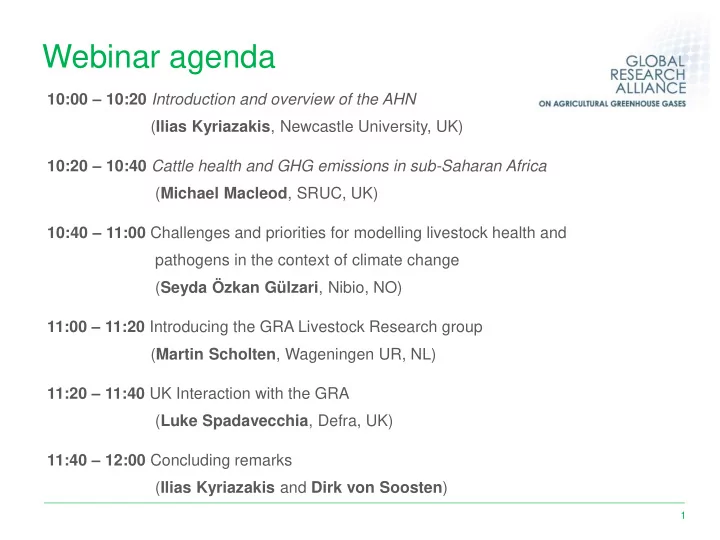

Webinar agenda 10:00 – 10:20 Introduction and overview of the AHN ( Ilias Kyriazakis , Newcastle University, UK) 10:20 – 10:40 Cattle health and GHG emissions in sub-Saharan Africa ( Michael Macleod , SRUC, UK) 10:40 – 11:00 Challenges and priorities for modelling livestock health and pathogens in the context of climate change ( Seyda Özkan Gülzari , Nibio, NO) 11:00 – 11:20 Introducing the GRA Livestock Research group ( Martin Scholten , Wageningen UR, NL) 11:20 – 11:40 UK Interaction with the GRA ( Luke Spadavecchia , Defra, UK) 11:40 – 12:00 Concluding remarks ( Ilias Kyriazakis and Dirk von Soosten ) 1
Animal Health and Greenhouse Gas Emissions Intensity Network Webinar 2 October 2017 Presented by: Professor Ilias Kyriazakis, Newcastle University, UK
Overview of presentation • Animal Health and GHG – What is the issue? • Introduction to the GRA and Animal Health Network • Sources of further information 3
Animal Health & GHG – What is the issue? Global importance • 40% agricultural GDP • Employment • 1/3 of humanity’s protein • Demand ↑ • Production ↑ • Environmental impact? Steinfeld et al. (2006 ) 4
What can be done? • On average, 20% animal disease losses due to animal diseases • ↑ mortality • ↓ fertility • ↓ productivity (disease & parasite) • = ↑ emissions intensity (individual & herd level) 5
Global Research Alliance (GRA) • Scope • Increase agricultural production with lower emissions • Improve global cooperation in research • Working with farmers and partners to provide knowledge • Structure • 4 Research Groups (including Livestock Research Group) • Alliance Council and Secretariat • Further info at www.globalresearchalliance.org/ 6
Animal Health Network context and aim • GHG emission intensities from livestock farming could be reduced through efficiency and production gains resulting from improved livestock health • The Network aims to bring together researchers (in veterinary science, epidemiology, animal science, modelling etc.) to explore links and synergies between animal disease control and reductions in GHG emission intensities 7
Network objectives 1. Share information on current and planned research and funding activities 2. Maintain and enhance capacity in this field of research 3. Encourage and facilitate a joined-up approach 4. Establish common agreement on priority issues and explore funding opportunities 5. Pursue synergies with stakeholders and other relevant initiatives 8
Network Co-ordinators and Champions • Lead Network Co-ordinator: Professor Ilias Kyriazakis (Newcastle University, UK) • Past Joint Network Co-ordinator: Dr Tim Robinson (FAO, Italy) • New joint Network Co-ordinator: Dr Dirk von Soosten (Friedrich-Loeffler-Institut, Federal Research Institute for Animal Health, Germany) Network Champions: Abdul Chaudhry, Michael Macleod, Jos Houdijk (UK); Wim van der Poel (NL); Seyda Özkan Gülzari (NO) Champions in other countries are welcomed 9
Network Secretariat • Secretariat role is due to be taken over by Dr Dirk von Soosten (FLI, Germany) To date, the establishment and running of the network has been carried out by ADAS (UK): • Funded by Defra for 3.5 years • Central contact point • Network promotion and communications • Members database • Organisation of Network meetings/workshops 10
Progress to date • Wide promotion to increase membership • >80 members across 25 countries • 5 Network Champions • 3 Annual Network workshops (Ireland, France & Denmark) • 1 regional workshop (Ethiopia) • Developed links with FACCE-JPI, MACSUR, GASL, STAR-IDAZ and NEAT • Identified potential funding routes • Communications e.g. UK newsletter 11
Links with initiatives and networks 12
Examples of relevant research • Modelling the Impact of Controlling Endemic Cattle Diseases and Conditions on Greenhouse Gas Emissions. (Led by ADAS, Defra project AC0120) (final report available on Defra Science website) • Periparturient parasitism and methane intensity for lamb production (SRUC, Scottish government funded) (Houdijk et al. 2015 Adv Anim Biosci 6, 258) • Cattle health and GHG emissions in sub-Saharan Africa (Michael Macleod to present findings today) • Challenges and priorities for modelling livestock health and pathogens in the context of climate change (Seyda Özkan Gülzari to present findings today) 13
Network information • Network Secretariat: Members will be contacted by the new secretariat • UK Agri-Science & Innovation Newsletters • GRA Livestock Research Group Newsletters • Network webpage on the GRA website www.globalresearchalliance.org 14
Recommend
More recommend